Microsoft Surface Pro Review
by Anand Lal Shimpi on February 5, 2013 9:00 PM ESTDisplay: Awesome if Calibrated
Surface RT used a 10.6-inch 1366 x 768 display, for Surface Pro Microsoft integrated a full 1920 x 1080 panel of the same size. The increase in resolution is appreciable and you definitely notice it when switching between the two Surface models. Pixel density isn’t class leading, but it’s at least in the right range. On the desktop, Microsoft enables 150% DPI scaling by default which makes everything legible but still a bit odd in applications that don't deal well with fractional DPI scaling. Ideally I would've liked to have seen a clean doubling to avoid this mess.
The higher res display just makes everything sharper in the modern UI, and the 150% DPI scaling in desktop mode makes everything big enough where the higher res isn't a problem there. It's only in those desktop applications that don't properly implement Windows DPI scaling where the higher resolution is a hindrance. I actually ran into this problem using Chrome on the desktop, where my taps wouldn't always map to the right parts of the application (not to mention that Chrome in DPI scaled Windows looks terrible). Thankfully there is always the pen...
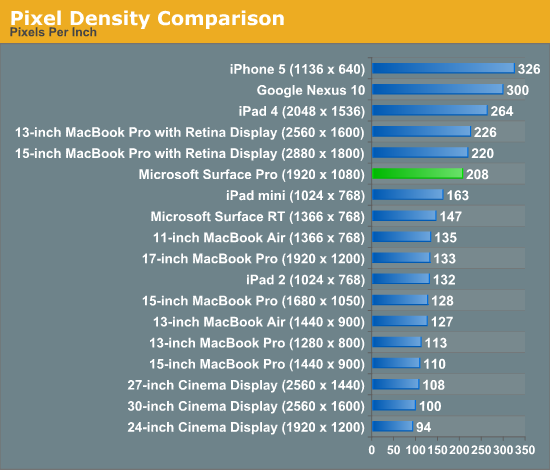
Once again Microsoft doesn’t do any substantial color calibration at the factory, but unlike on Surface RT you can run your own Windows display calibration software on Surface Pro to improve color accuracy if you have the right equipment.
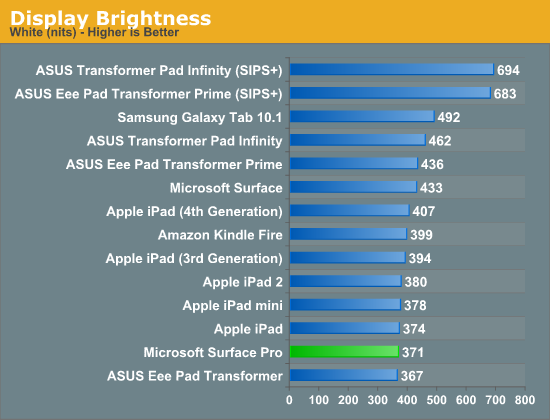
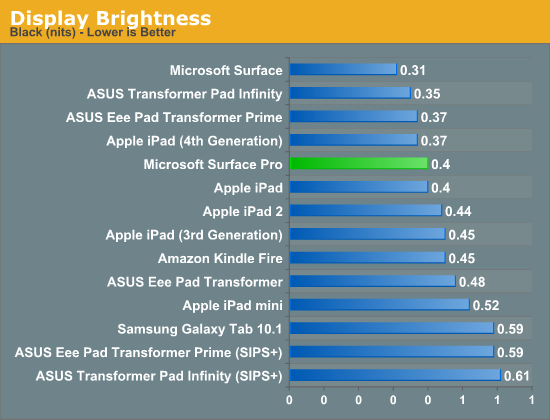
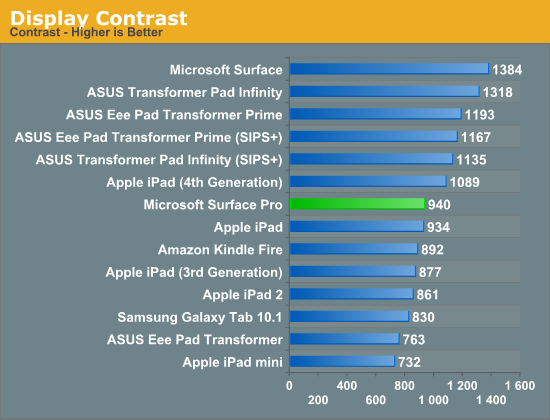
Out of the box my Surface Pro sample had an unusually high white point (~7500K), which negatively impacted its grayscale accuracy. To evaluate color accuracy I turned to our own Chris Heinonen's CalMAN smartphone/tablet workflow. Color accuracy is near identical to Surface RT, which is to say that it’s ok compared to PC notebooks from a couple of years ago but still far behind what you get out of the box from Apple.
Given that the majority of users don’t do any color calibration on their PCs, this becomes a real problem for consumer perception if your tablet doesn’t ship with accurate colors by default.
To see what the panel is capable of I ran it through our standard PC display calibration routine (which I can do since it’s running Windows 8 and is effectively a PC). I then re-ran it through our CalMAN smartphone/tablet workflow and ended up with much more pleasing results. While the display still lagged behind the iPad in one of the tests, it bested Apple’s Retina Display in the other two color accuracy benchmarks.
We'll start off by looking at the calibrated white point for these tablets. What you're looking for here is a number close to 6500K:
The next three charts look at accuracy represented as a difference between various source colors and what's reproduced on the display. The results are presented as average dE2000, with lower numbers being better.
First up is Grayscale performance, here we're looking at the accuracy of black, white and 19 shades of gray spread in between the two extremes:
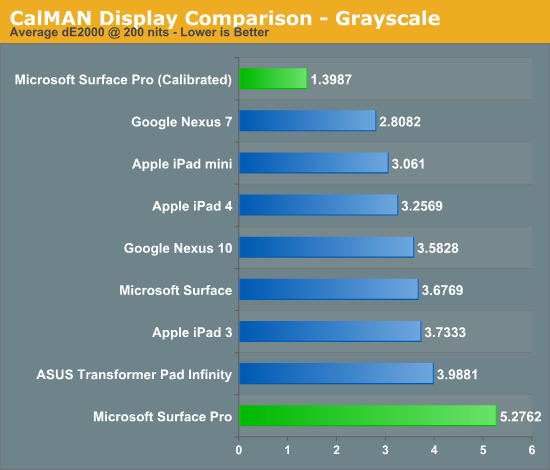
Out of the box grayscale performance is abysmal on Surface Pro. Calibrated accuracy, on the other hand, is just awesome.
First in our color accuracy tests is a saturation sweep. Here we're looking at 20%, 40%, 60%, 80% and 100% saturations of red, blue, green, magenta, yellow and cyan.
Our saturation sweep is the only test where even a calibrated Surface Pro can't match the iPad, it does do a lot better than Surface Pro without any color calibration however. Out of the box Surface Pro is considerably worse than any Apple tablet.
Gamut CIE Chart

Saturation CIE Chart
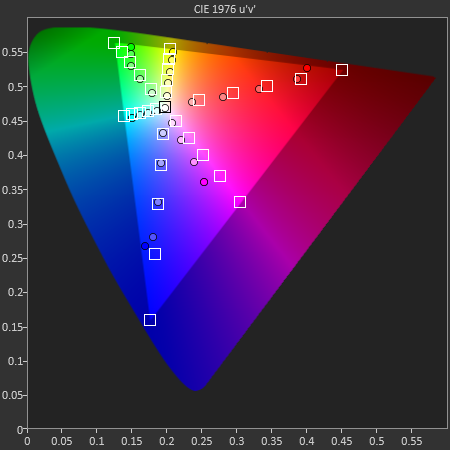
For our final accuracy test we're looking at the difference between a Gretag Macbeth colorchecker chart and the rendered swatches on these displays. Once again, lower numbers are better.
Out of the box Surface Pro and Surface RT are near identical here, and similar to the Nexus 10. With a good suite of calibration tools and supported hardware under Windows 8, Surface Pro has the potential to easily outperform the iPad if given the opportunity.
GMB Color Checker
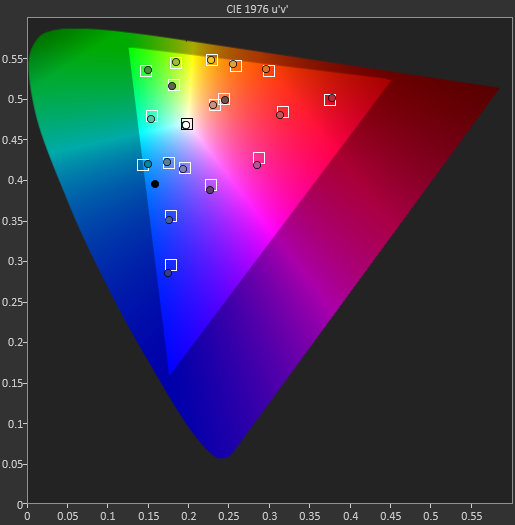
Surface Pro’s panel has real potential, it just needs a calibration pass - which is honestly something Microsoft should be doing these days, not the end user.
Mini DisplayPort but No Thunderbolt
Surface RT featured a single video output in the form of a micro HDMI port. Surface Pro adopts a mini DisplayPort output instead, and will have adapters to enable DVI and HDMI support.
The miniDP output immediately activates as soon as you plug a display into it. I sometimes had issues with display resolutions being set sub optimally, but generally speaking the process was as plug and play as you can get.
I did notice some visual tearing on the Surface Pro display when connected to an external HDMI monitor, similar to what I saw with Surface RT but not nearly as bad. I’m beginning to think something is a bit wonky with Windows 8’s multi-monitor support. What’s interesting is I didn’t see the issue on all displays, which is more than I can say for Surface RT. Update: It looks like this is hardware related. Even if the internal and external panels have the same refresh rate, Intel's HD 4000 won't guarantee that the refreshes will happen at the same time - which is why we see tearing. The tearing should only be present in clone mode, not extended desktop (I'll verify this shortly). It seems like Tegra 3 is worse in this regard, which is why the issue was so much more prevalent on Surface RT. I need to check other Ivy Bridge platforms and under OS X to see if the problem is as prevalent there as well.
The only disappointment here is Microsoft opted against integrating Thunderbolt into Surface Pro. I feel like Thunderbolt would’ve made a ton of sense in a device like Surface Pro, enabling one cable connection to both an external display and high-speed external storage. Given that Thunderbolt adoption remains fairly limited in the PC space I don’t think this is a huge loss for most of Microsoft’s target customer base, but I do feel like it’d be a good way of future proofing the device. The alternative that Surface Pro offers is the combination of miniDP and USB 3.0, which realistically speaking is probably good enough for most users. From a cost of integration standpoint vs. the number of users who would pay for it, it probably didn’t make sense for Microsoft to include Thunderbolt in Surface Pro, but that doesn’t change the fact that I wish it was there. It’d be nice for Apple not to be the only company really pushing Thunderbolt.
Camera Quality
Surface Pro, like Surface RT before it, features two integrated 720p cameras with no flash. Admittedly I didn't spend a ton of time taking photos with Surface Pro but imaging quality is just really bad compared to what you'll get out of an iPad 4. The results are borderline ok for use on the web but that's pretty much it, and forget about decent low light performance.


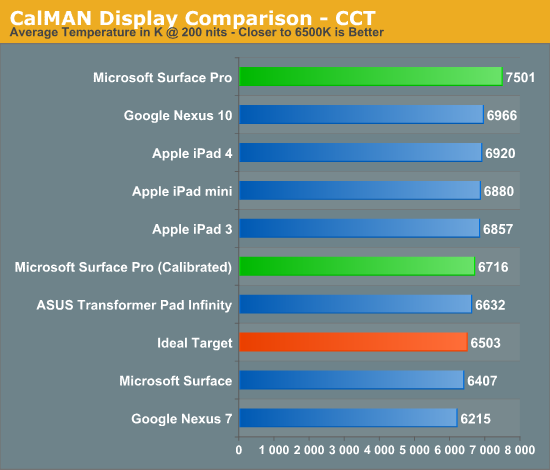
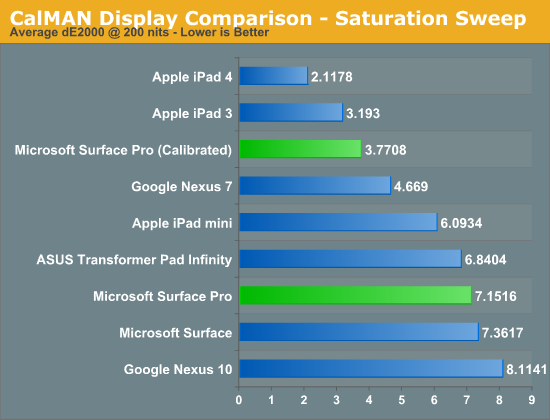
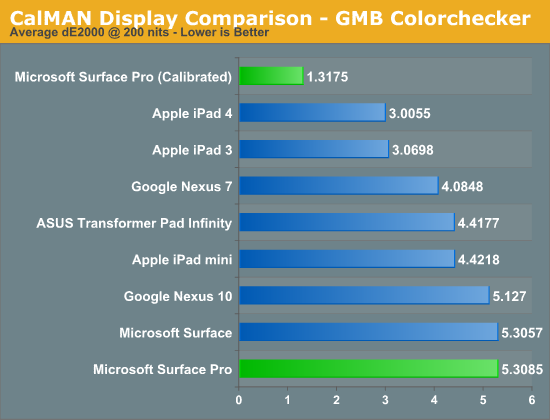










228 Comments
View All Comments
BSMonitor - Wednesday, February 6, 2013 - link
Because most people who are hardware reviewers see red flags only.. $899.. And the rest of the review is based on that..Surface Pro is the MOST productive tablet available. BY FAR. Why? because it's a PC in tablet form.
BSMonitor - Wednesday, February 6, 2013 - link
Has there been any talk/musings about a hybrid APU featuring both an Atom and the traditional Ivy Bridge/Haswell cores on a single die??I believe your last podcast mentioned the Octus or Octal or whatever in the ARM space. Seems like for a powerful, but mobile Surface Pro, this is a no brainer. If I want to switch to battery life mode and get 9-10 hours, Win 8 can be made to only schedule on the Atoms and power gate off Haswell.
Or does Intel really believe they can get Haswell and beyond into the power space of Atom/ARM??
dcianf - Wednesday, February 6, 2013 - link
The review said that in power saver mode it runs at 800MHz. Can you force the low clock rate? If so, how would performance and battery life compare to ARM?Netscorer - Wednesday, February 6, 2013 - link
That's actually a good point. Anand delivered performance charts based on fully powered core i5 and battery results based on clocked chip at 800MHz. Many people don't realize that you don't get both (and review does not help to highlight that difference) - either you are using it in light mode for stated hours or you run some complex program and have to be always connected because CPU would seep power like a thirsty kid on hot afternoon.marco89nish - Wednesday, February 6, 2013 - link
I also want to see how much battery life you can get on power saving mode. Peformance would also be nice, but it's predictable I guess, So, please, battery life on power saving mode. I registered to post this comment.smartypnt4 - Wednesday, February 6, 2013 - link
Anand, are you guys planning on reviewing the ASUS TAICHI21? The base model is $1300, which is only $170 more than the Surface Pro with a Type Cover, and it solves the lap usage problem while maintaining mostly the same battery life. I'll grant that it's a bit heavier, but I've got one and I absolutely love it. Those screens are just stunning.Beenthere - Wednesday, February 6, 2013 - link
That was just another scam by InHell.twotwotwo - Wednesday, February 6, 2013 - link
The Pro seems, in this and other reviews, to always get the unfavorable comparison on each dimension--it's not a thinner, lighter thin-and-light, it's either a heavy, bulky iPad or a bit slow for the most advanced games, depending on context.Microsoft seems to be betting that some folks can live with tradeoffs to get a super portable fully-functional computer. I really hope they're right; I'd like my next computer to be like this, and I'll have more options if this (or something like the Acer W700--I'd happily lose the pen and apparently unreliable covers) does well.
scsi stud - Wednesday, February 6, 2013 - link
Hi Anand,Would yod mind posting up a screenshot of the Surface Pro's desktop in full 1080p resolution? I'm curious to see how an application like Visual Studio 2012 would look like.
My hopes for this device were to be my go-to device for sitting on my couch writing code after I put my kids to sleep...
Thanks in advance.
spencer.p - Wednesday, February 6, 2013 - link
I am curious, Anand, if you can test to see if the Surface Pro works with the widi standard that Intel is pushing out and if it's also possible to get the Surface Pro to a 30" dual-link DVI monitor via one of those mini-displayport to dual-link DVI adapters. I am really curious if the Surface Pro will be able to meet my use case.